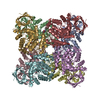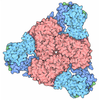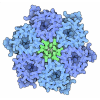[English] 日本語
 Yorodumi
Yorodumi- PDB-8ihq: Cryo-EM structure of ochratoxin A-detoxifying amidohydrolase ADH3 -
+ Open data
Open data
- Basic information
Basic information
| Entry | Database: PDB / ID: 8ihq | |||||||||||||||||||||||||||||||||||||||
|---|---|---|---|---|---|---|---|---|---|---|---|---|---|---|---|---|---|---|---|---|---|---|---|---|---|---|---|---|---|---|---|---|---|---|---|---|---|---|---|---|
| Title | Cryo-EM structure of ochratoxin A-detoxifying amidohydrolase ADH3 | |||||||||||||||||||||||||||||||||||||||
 Components Components | Amidohydrolase family protein | |||||||||||||||||||||||||||||||||||||||
 Keywords Keywords | HYDROLASE / amidohydrolase / octamer / ochratoxin A degradtion / cryo-EM structure | |||||||||||||||||||||||||||||||||||||||
| Function / homology | hydrolase activity, acting on carbon-nitrogen (but not peptide) bonds / Amidohydrolase family / Metal-dependent hydrolase, composite domain superfamily / Amidohydrolase-related / Metal-dependent hydrolase / Amidohydrolase family protein Function and homology information Function and homology information | |||||||||||||||||||||||||||||||||||||||
| Biological species |  Stenotrophomonas acidaminiphila (bacteria) Stenotrophomonas acidaminiphila (bacteria) | |||||||||||||||||||||||||||||||||||||||
| Method | ELECTRON MICROSCOPY / single particle reconstruction / cryo EM / Resolution: 2.71 Å | |||||||||||||||||||||||||||||||||||||||
 Authors Authors | Dai, L.H. / Niu, D. / Huang, J.-W. / Li, X. / Shen, P.P. / Li, H. / Hu, Y.M. / Yang, Y. / Chen, C.-C. / Guo, R.-T. | |||||||||||||||||||||||||||||||||||||||
| Funding support |  China, 1items China, 1items
| |||||||||||||||||||||||||||||||||||||||
 Citation Citation |  Journal: J Hazard Mater / Year: 2023 Journal: J Hazard Mater / Year: 2023Title: Cryo-EM structure and rational engineering of a superefficient ochratoxin A-detoxifying amidohydrolase. Authors: Longhai Dai / Du Niu / Jian-Wen Huang / Xian Li / Panpan Shen / Hao Li / Zhenzhen Xie / Jian Min / Yumei Hu / Yu Yang / Rey-Ting Guo / Chun-Chi Chen /  Abstract: Ochratoxin A (OTA) is among the most prevalent mycotoxins detected in agroproducts, posing serious threats to human and livestock health. Using enzymes to conduct OTA detoxification is an appealing ...Ochratoxin A (OTA) is among the most prevalent mycotoxins detected in agroproducts, posing serious threats to human and livestock health. Using enzymes to conduct OTA detoxification is an appealing potential strategy. The recently identified amidohydrolase from Stenotrophomonas acidaminiphila, termed ADH3, is the most efficient OTA-detoxifying enzyme reported thus far and can hydrolyze OTA to nontoxic ochratoxin α (OTα) and L-β-phenylalanine (Phe). To elucidate the catalytic mechanism of ADH3, we solved the single-particle cryo-electron microscopy (cryo-EM) structures of apo-form, Phe- and OTA-bound ADH3 to an overall resolution of 2.5-2.7 Å. The role of OTA-binding residues was investigated by structural, mutagenesis and biochemical analyses. We also rationally engineered ADH3 and obtained variant S88E, whose catalytic activity was elevated by 3.7-fold. Structural analysis of variant S88E indicates that the E88 side chain provides additional hydrogen bond interactions to the OTα moiety. Furthermore, the OTA-hydrolytic activity of variant S88E expressed in Pichia pastoris is comparable to that of Escherichia coli-expressed enzyme, revealing the feasibility of employing the industrial yeast strain to produce ADH3 and its variants for further applications. These results unveil a wealth of information about the catalytic mechanism of ADH3-mediated OTA degradation and provide a blueprint for rational engineering of high-efficiency OTA-detoxifying machineries. | |||||||||||||||||||||||||||||||||||||||
| History |
|
- Structure visualization
Structure visualization
| Structure viewer | Molecule:  Molmil Molmil Jmol/JSmol Jmol/JSmol |
|---|
- Downloads & links
Downloads & links
- Download
Download
| PDBx/mmCIF format |  8ihq.cif.gz 8ihq.cif.gz | 576 KB | Display |  PDBx/mmCIF format PDBx/mmCIF format |
|---|---|---|---|---|
| PDB format |  pdb8ihq.ent.gz pdb8ihq.ent.gz | 477.8 KB | Display |  PDB format PDB format |
| PDBx/mmJSON format |  8ihq.json.gz 8ihq.json.gz | Tree view |  PDBx/mmJSON format PDBx/mmJSON format | |
| Others |  Other downloads Other downloads |
-Validation report
| Summary document |  8ihq_validation.pdf.gz 8ihq_validation.pdf.gz | 1.4 MB | Display |  wwPDB validaton report wwPDB validaton report |
|---|---|---|---|---|
| Full document |  8ihq_full_validation.pdf.gz 8ihq_full_validation.pdf.gz | 1.4 MB | Display | |
| Data in XML |  8ihq_validation.xml.gz 8ihq_validation.xml.gz | 93 KB | Display | |
| Data in CIF |  8ihq_validation.cif.gz 8ihq_validation.cif.gz | 138.8 KB | Display | |
| Arichive directory |  https://data.pdbj.org/pub/pdb/validation_reports/ih/8ihq https://data.pdbj.org/pub/pdb/validation_reports/ih/8ihq ftp://data.pdbj.org/pub/pdb/validation_reports/ih/8ihq ftp://data.pdbj.org/pub/pdb/validation_reports/ih/8ihq | HTTPS FTP |
-Related structure data
| Related structure data |  35452MC  8ihrC  8ihsC  8j85C M: map data used to model this data C: citing same article ( |
|---|---|
| Similar structure data | Similarity search - Function & homology  F&H Search F&H Search |
- Links
Links
- Assembly
Assembly
| Deposited unit | 
|
|---|---|
| 1 |
|
- Components
Components
| #1: Protein | Mass: 45717.617 Da / Num. of mol.: 8 Source method: isolated from a genetically manipulated source Source: (gene. exp.)  Stenotrophomonas acidaminiphila (bacteria) Stenotrophomonas acidaminiphila (bacteria)Gene: H7691_12935 / Production host:  #2: Chemical | ChemComp-ZN / Has ligand of interest | Y | Has protein modification | Y | |
|---|
-Experimental details
-Experiment
| Experiment | Method: ELECTRON MICROSCOPY |
|---|---|
| EM experiment | Aggregation state: PARTICLE / 3D reconstruction method: single particle reconstruction |
- Sample preparation
Sample preparation
| Component | Name: ADH3 / Type: COMPLEX / Entity ID: #1 / Source: RECOMBINANT |
|---|---|
| Source (natural) | Organism:  Stenotrophomonas acidaminiphila (bacteria) Stenotrophomonas acidaminiphila (bacteria) |
| Source (recombinant) | Organism:  |
| Buffer solution | pH: 7.5 / Details: 20 mM Tris-HCL,pH 7.5 |
| Specimen | Conc.: 0.6 mg/ml / Embedding applied: NO / Shadowing applied: NO / Staining applied: NO / Vitrification applied: YES |
| Vitrification | Cryogen name: ETHANE |
- Electron microscopy imaging
Electron microscopy imaging
| Experimental equipment |  Model: Titan Krios / Image courtesy: FEI Company |
|---|---|
| Microscopy | Model: FEI TITAN KRIOS |
| Electron gun | Electron source:  FIELD EMISSION GUN / Accelerating voltage: 300 kV / Illumination mode: FLOOD BEAM FIELD EMISSION GUN / Accelerating voltage: 300 kV / Illumination mode: FLOOD BEAM |
| Electron lens | Mode: BRIGHT FIELD / Nominal defocus max: 2400 nm / Nominal defocus min: 1000 nm |
| Image recording | Electron dose: 52 e/Å2 / Film or detector model: GATAN K3 (6k x 4k) |
- Processing
Processing
| Software | Name: PHENIX / Version: 1.20.1_4487: / Classification: refinement | ||||||||||||||||||||||||
|---|---|---|---|---|---|---|---|---|---|---|---|---|---|---|---|---|---|---|---|---|---|---|---|---|---|
| EM software | Name: PHENIX / Category: model refinement | ||||||||||||||||||||||||
| CTF correction | Type: PHASE FLIPPING AND AMPLITUDE CORRECTION | ||||||||||||||||||||||||
| 3D reconstruction | Resolution: 2.71 Å / Resolution method: FSC 0.143 CUT-OFF / Num. of particles: 141155 / Symmetry type: POINT | ||||||||||||||||||||||||
| Refine LS restraints |
|
 Movie
Movie Controller
Controller





 PDBj
PDBj



